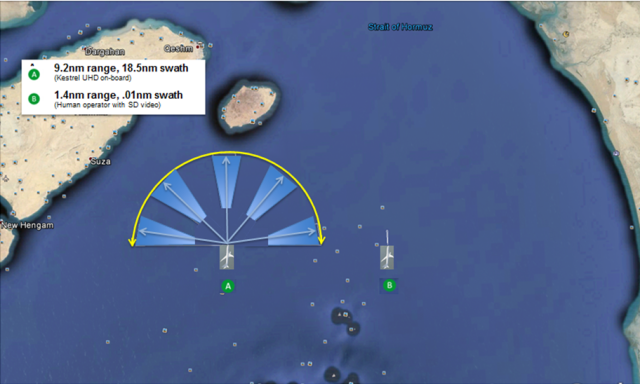Sentient has announced that the Royal Australian Navy has procured a license for its Kestrel Maritime ViDAR wide area maritime detection software to support RAN UAS activities. The software is designed to be incorporated into a purpose built ViDAR payload that can be modularly applied to the existing Block D Scan Eagle currently being flown by the Navy.
“Kestrel Maritime ViDAR has the potential to be game changing for Naval UAS operations” said Simon Olsen, Sentient’s Director of Business Development, Strategy and Partnerships. “Small payload capacity and limited bandwidth restrict tactical UAS to primarily provide surveillance over objects of interest that have already been detected”. Typically detection of objects in the ocean requires manned aircraft with much greater payload capacity – aircraft which are often expensive to operate and deploy. “Kestrel Maritime ViDAR now gives a UAS like the Scan Eagle the crucial capability to search as well as to conduct surveillance, dramatically increasing its usefulness to the RAN” said Olsen.
“The Navy is looking at the Kestrel Maritime ViDAR trials to potentially support, among other systems, wide area maritime surveillance” said Captain Allen Whittaker, RAN.
Insitu Pacific Ltd (IPL) will be trialing the Kestrel Maritime ViDAR payload for the RAN as a part of their support to ongoing Navy UAS experimentation activity. “ViDAR provides a critical point of difference for the Scan Eagle UAS enabling it to now scan significant areas autonomously in both blue water and littoral environments”, said Andrew Duggan, IPL’s Managing Director
Kestrel Maritime ViDAR Kestrel Maritime ViDAR consists of a 9 megapixel second sensor on board a Scan Eagle and onboard automation software designed to automatically detect objects on the ocean in real time. The 9 megapixel sensor works autonomously from the operator, scanning the ocean’s surface in a 180 degree arc around the front of the Scan eagle. It operates similarly to airborne radar, but in the visual domain. Objects detected are sent to the operator on the ground as images and map location points in real time. Once detected, the operator can select the objects of interest enabling the primary sensor to be cross cued for interrogation/classification. A Scan Eagle equipped with a ViDAR payload can autonomously cover over 80 times the ocean’s surface as compared with existing EO/IR sensors.
Source: Press Release


